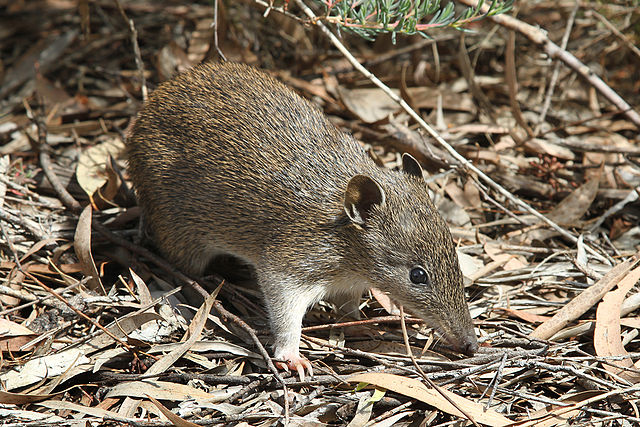The Southern Brown Bandicoot
About
Southern brown bandicoots have a long, pointy nose that they use to forage in the soil for insects and fungi. In doing so, they create small holes, which help increase nutrient turnover, aerate the soil, and improve water penetration, making them true environmental champions!
Just one southern brown bandicoot can turn over 3.9 tonnes of soil in a year - that’s the equivalent of up to four ute loads of soil!
Don’t confuse bandicoots for a rat! Southern brown bandicoots are typically larger than a rat but smaller than a rabbit and far more important to our natural environment.
Although populations still exist in the Koo Wee Rup, Bayles, Cardinia, Lang Lang and the Garfield/Bunyip areas, numbers of Southern Brown Bandicoots are generally declining.
This decline in population is due to:
- land clearing for agriculture and housing
- predation by feral and domestic animals (foxes, cats, dogs)
- disruption of movement corridors
- isolation from other bandicoots.

Preferred habitat
The best habitat for Southern brown bandicoots is dense understory vegetation, such as small shrubs and long grass. This provides protection from predators, especially if plants are prickly.
Weeds such as blackberry, logs and woody debris also provide shelter and nesting sites. Weed control and site clean-up should therefore be done in stages, so there is always protective cover available while waiting for newly revegetated plants to establish.
Linear strips of vegetation (both native and exotic weeds) along drains, waterways, roads, rail reserves and private property are vital in connecting fragmented patches of habitat.
Council’s Natural Reserves Team has been actively working to create artificial habitat that protect and shelter the endangered southern brown bandicoots along the Koo Wee Rup Rail Trail, while staged weed control works are undertaken.
Check out our video and see our team at work: Watch the video | Artificial habitat for the Southern Brown Bandicoots
What can you do?
You can:
- practice responsible pet ownership by desexing pets, keeping cats indoors, and ensuring dogs are on a lead in public areas (except in designated off-leash areas). These measures will enhance the wellbeing of your pets and ensure the safety of local wildlife.
- become a citizen scientist – upload new bandicoot sightings into the iNaturalist app. More information about how to report bandicoot sightings head to How to use iNaturalist - Cardinia Shire Council
- protect and increase remnant vegetation on your property.
- gradually remove weeds from your property and replace with indigenous plants. Check out our indigenous plant guide to help with plant selection.
- create a garden for wildlife.
- join a reserve Friends group or Landcare group to help improve local habitat.
- join the Royal Botanic Gardens Bandicoot Brigade to learn more about these wonderful Australian animals.
Bandicoot sightings in Koo Wee Rup
Have you seen our outdoor pavement stickers along the Koo Wee Rup Rail Trail? These stickers are marking 'bandicoot sightings' and serve as reminders for residents to keep their dogs on lead and ensure their cats remain on private property.
A collaborative effort between governments and community aims to safeguard the southern brown bandicoots and preserve biodiversity in the Koo Wee Rup area. Together, we can make a significant impact!
Victorian Government strategy
The Victorian Government developed a sub regional species strategy for the southern brown bandicoot in 2014 to ensure the long-term viability of the species and its habitat in the former Koo Wee Rup swamp area.
The strategy stands the greatest chances of success if the community can also provide habitat to support the species.
More information about the southern brown bandicoot and the sub-regional species strategy can be found on the Victorian Government’s website.
